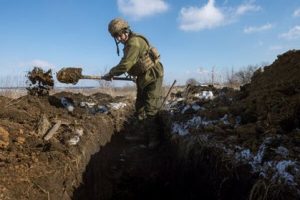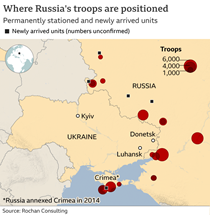Tensions Rise as Russian Military Buildup Near Ukraine Continues
Michael Morano
International/U.S. News Editor
Russia has now amassed at least 70% of the military capability it needs to launch a full-scale invasion of Ukraine, according to U.S. officials. This further adds to the tension between the two countries as a result of the mass buildup of Russian military forces along the Ukrainian border in recent weeks.
While a diplomatic solution has not yet been ruled out, officials warn that Russian President Vladimir Putin still has the option to launch an invasion in the near future, with the most likely window beginning around the middle of February and into March. If an aggressive option is chosen, officials believe that Russian forces could surround or capture the Ukrainian capital Kyiv or even remove Ukrainian President Volodymyr Zelensky. Should this invasion happen, it would be what the officials believe to be the largest military operation on European land since 1945. It would also lead to a humanitarian crisis on the European continent, with thousands of Ukrainian citizens fleeing the capital and surrounding areas and becoming refugees. Hundreds of citizens and soldiers alike could be killed or wounded as the Russians move in.

Despite the current tensions, Putin has denied that Russia will invade its neighbor. He has instead called for the denial of Ukraine’s membership into NATO, as well as the recall of military deployments in Central and Eastern Europe by NATO members. He has also accused NATO and the U.S. of using Ukraine as “a tool” in efforts to contain Russia. U.S. President Joe Biden has said that he will not send American soldiers to Ukraine should the conflict escalate further, but he has ordered troops into neighboring Poland and Romania to protect NATO territory from Russian aggression. American and European officials have also warned that an attack on Ukraine would lead to increased sanctions, trade restrictions, and freezing of the accounts of Russian leaders.

The U.S. reports and media have also come into question, with them and the U.K. being accused of exaggerating the threat, which both countries have denied. “Do not believe the apocalyptic predictions,” Ukraine’s Foreign Minister Dmytro Kuleba said. “Different capitals have different scenarios, but Ukraine is ready for any development.” Russian diplomat and UN representative Dmitry Polyanskiy called the U.S. media reports “madness and scaremongering.” It is also unclear of how the U.S. determined their estimates, as they show that up to 50,000 casualties could result from any future conflict.
French President Emmanuel Macron and Putin met Monday in response to the recent developments to continue to push for a de-escalation. “This dialogue is absolutely essential, more than ever, to ensure the stability and security of the European continent,” Macron said. President Biden and German Chancellor Olaf Scholz also met Monday during which Biden promised a “united” effort to combat Russia, despite concerns that Scholz and Germany have not been as forceful about the Russian buildup compared to some of its allies. He has refused to send arms to Ukraine and has not been clear on if or any sanctions he would impose should an invasion happen, but he is still in the fight. “The reality is that Germany is the biggest NATO partner in continental Europe, that we are continuously strengthening our military forces.” Scholz said in an interview with The Washington Post. “We are cooperating with our allies in NATO and with the United States on the question of how to react to this threat.”
Contact Michael at michael.morano1@student.shu.edu

